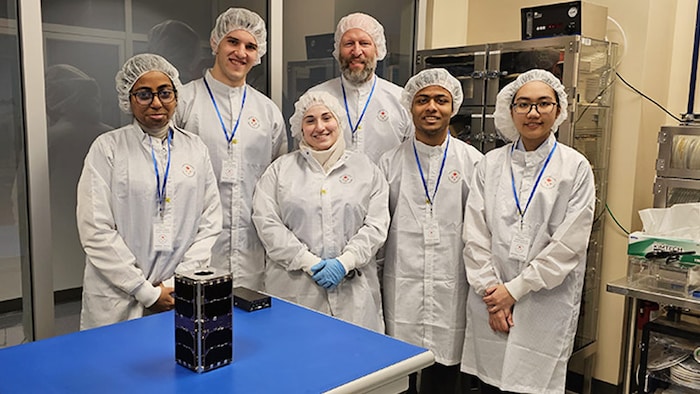Open in full screen mode The UNB team with the Violet satellite during tests at the Canadian Space Agency in Montreal. Radio-Canada< p class="text-medium leading-6 text-gray600 light:text-gray600 dark:text-gray400">Speech synthesis, based on artificial intelligence, makes it possible to generate spoken text from written text. Engineering students from the Université de Moncton, CCNB and the University of New Brunswick (UNB) worked for five years to design the first New Brunswick satellite that will be sent into the world. ;space, next March. The satellite, named Violet after the province's floral emblem, will be the last of 14 created as part of the pan-Canadian CubeSat project, which saw 15 educational institutions across the country create their own satellites with the help of the Canadian Space Agency.
UNB teacher Brent Petersen (left) and students work on Violet, New Brunswick's first satellite to travel into space.
In total, approximately 300 students worked on this project in New Brunswick. The Université de Moncton developed the software, while the CCNB and UNB took care of the manufacturing and testing.
The satellite was was handed over to the Canadian Space Agency in Montreal last week.
The launch from the Kennedy Space Center in Florida to the International Space Station is scheduled for March 4. The object will then be put into orbit in May.
UNB mechanical engineering student Noah Lydon devoted all his time to this project over the past seven months.
Loading
What to decode from the message from the Bank of Canada?
ELSEWHERE ON NEWS: What to decode from the Bank of Canada's message?
It's a very small satellite, the size of a bread box. He will study the weather and the atmosphere, he explains.
The Violet satellite will launch to the International Space Station on March 4, 2024.
He adds that the students who worked on this device were nervous.
That's a lot of hours of work, especially at the very end when it came time to put all the pieces together.
A quote from UNB engineering student Noah Lydon
All this work paid off, as officials at the Canadian Space Agency were impressed by the work of the New Brunswick students. The checks were carried out without any problems.
According to UNB electrical and computer engineering professor Brent Petersen, this project is beneficial for learning how to build systems that must be perfect to function well.
But it is also practical experience in relation to the laws and regulations that we must follow in engineering, he specifies. The students did a fantastic job with this Canadian CubeSat project.
Whether you are building a bridge, a robot or a satellite, there are many regulations to follow for safety, continues the UNB teacher. This project allowed students to experience all facets of a project, a situation they will encounter later in their careers, he says.
But the project is not finished, because we still need to collect data from the satellite.
This will be the role of Samiha Lubaba, a master's student at UNB in electrical engineering.
The International Space Station will launch the Violet satellite in May, along with the others from the Canadian CubeSat program.
She will operate an antenna from the control room and she should have 30 minutes of communication with the satellite each day.
We are increasingly facing extreme weather events, hence the idea to see if weather in space can predict some of these events, changes in temperature, etc. , she explains.
Due to the position of the Sun relative to the Earth, we expect that the satellite is functional for approximately three months before leaving its orbit and disintegrating in the atmosphere.
With information from Océane Doucet

